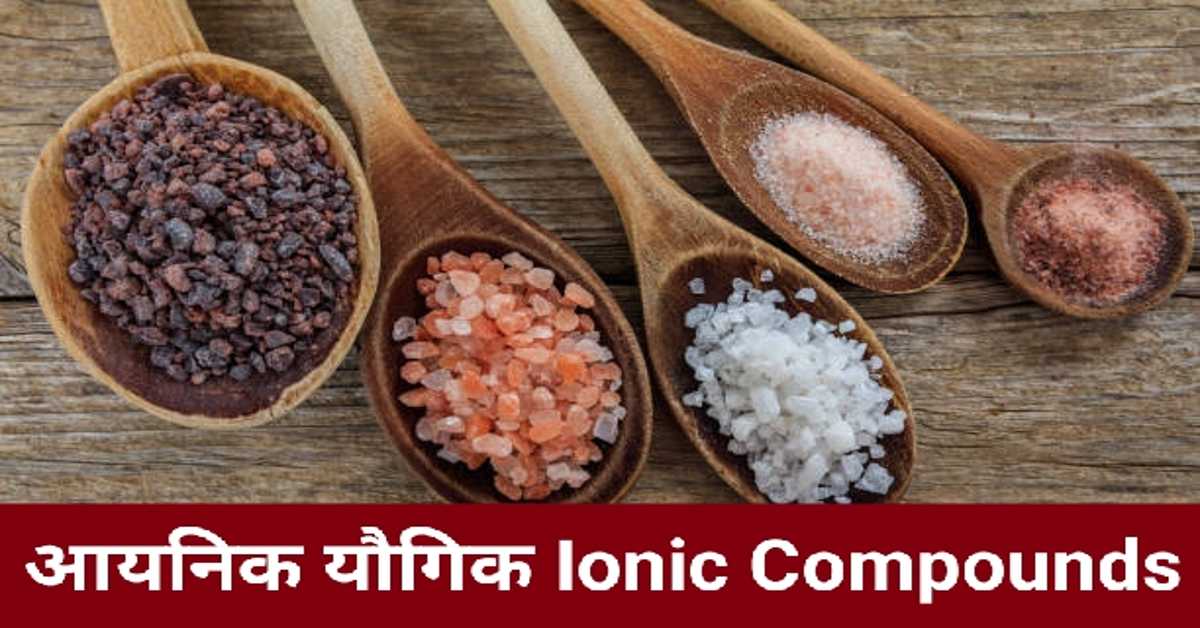
आयनिक यौगिकों के गुणधर्म | Properties Of Ionic Compounds
आयनिक यौगिकों के प्रमुख गुणधर्म निम्नलिखित हैं–
1. भौतिक प्रकृति
2. विद्युत चालकता
3. घुलनशीलता
4. गलनांक एवं क्वथनांक
The following are the main properties of ionic compounds–
1. Physical Nature
2. Electrical conductivity
3. Solubility
4. Melting Point and Boiling Point
रसायन विज्ञान के इन 👇 प्रकरणों को भी पढ़ें। (Also read these 👇 episodes of Chemistry.)
आयनिक यौगिक कैसे बनते हैं? | How Are Ionic Compounds Formed?
भौतिक प्रकृति (Physical Nature)
आयनिक यौगिकों के धनायनों और ऋणायनों के बीच मजबूत आकर्षण बल होता है। इस कारण ये यौगिक ठोस और कठोर होते हैं। सामान्यतः ये यौगिक भंगुर होते हैं और टुकड़ों में टूट सकते हैं।
The cations and anions of ionic compounds have a strong attraction force. Because of this these compounds are solid and hard. These compounds are generally brittle and can break into pieces.
रसायन विज्ञान के इन 👇 प्रकरणों को भी पढ़ें। (Also read these 👇 episodes of Chemistry.)
धातुओं की सक्रियता श्रेणी | Activity Series Of Metals
विद्युत चालकता (Electrical Conductivity)
प्रकृति के किसी विलियन से विद्युत के चालन के लिए आवेशित कणों का गतिशील होना आवश्यक होता है। आयनिक यौगिकों के जलीय विलियन में आयन उपस्थित रहते हैं। जब इस जलीय विलियन में विद्युत धारा प्रवाहित की जाती है, तो ये आयन विपरीत इलैक्ट्रोड की ओर गमन करने लगते हैं। अतः स्पष्ट है कि द्रव अवस्था में आयनिक यौगिक विद्युत के सुचालक होते हैं। जब आयनिक यौगिक ठोस अवस्था में रहते हैं, तो इनसे विद्युत का चालन नहीं हो पाता। इसका कारण यह है कि ठोस अवस्था में दृढ़ संरचना के कारण आयनों की गति संभव नहीं हो पाती। आयनिक यौगिक द्रव अवस्था में विद्युत का चालन करते हैं, क्योंकि द्रव अवस्था में विपरीत आवेश वाले आयनों के बीच स्थिर वैद्युत आकर्षण बल ऊष्मा की वजह से कमज़ोर हो जाता है। इसलिए आयन स्वतंत्र रूप से गमन करते हैं और विद्युत का प्रवाह सरलता से हो जाता है।
For the conduction of electricity through a solution of nature, it is necessary for the charged particles to move. Ions are present in aqueous solutions of ionic compounds. When an electric current is passed through this aqueous solution, these ions start moving towards the opposite electrode. Therefore, it is clear that ionic compounds are good conductors of electricity in the liquid state. When ionic compounds are in the solid state, they cannot conduct electricity. The reason for this is that due to the rigid structure in the solid state, the movement of ions is not possible. Ionic compounds conduct electricity in the liquid state because in the liquid state the electrostatic attraction between oppositely charged ions is weakened by heat. Therefore ions move freely and electricity can flow easily.
रसायन विज्ञान के इन 👇 प्रकरणों को भी पढ़ें। (Also read these 👇 episodes of Chemistry.)
धातुओं की लवणों के विलयन और अम्लों के साथ अभिक्रियाएँ | Reactions Of Metals With Solutions Of Salts And Acids
घुलनशीलता (Solubility)
वैद्युत संयोजक (आयनिक) यौगिक जल में घुलनशील होते हैं। पेट्रोल, केरोसिन आदि विलायकों में ये यौगिक अविलेय होते हैं।
Electrovalent (ionic) compounds are soluble in water. These compounds are insoluble in solvents like petrol, kerosene etc.
रसायन विज्ञान के इन 👇 प्रकरणों को भी पढ़ें। (Also read these 👇 episodes of Chemistry.)
धातुओं की जल के साथ रासायनिक अभिक्रियाएँ | Chemical Reactions Of Metals With Water
गलनांक एवं क्वथनांक (Melting Point and Boiling Point)
आयनिक यौगिकों के आयनों के मध्य मजबूत अंतर-आयनिक आकर्षण बल होता है। इसे तोड़ने के लिए बहुत अधिक ऊर्जा की आवश्यकता होती है। इसलिए इन आयनिक यौगिकों के गलनांक और क्वथनांक बहुत अधिक होते हैं।
Ionic compounds have strong intermolecular attraction forces between ions. It takes a lot of energy to break it. Therefore these ionic compounds have very high melting and boiling points.
रसायन विज्ञान के इन 👇 प्रकरणों को भी पढ़ें। (Also read these 👇 episodes of Chemistry.)
धातुओं की अम्ल, क्षारक और ऑक्सीजन के साथ अभिक्रिया | Reaction Of Metals With Acids, Bases And Oxygen
प्रकृति के कुछ महत्वपूर्ण आयनिक यौगिक एवं उनके गलनांक और क्वथनांक निम्नलिखित हैं–
1. सोडियम क्लोराइड– इसका गलनांक 1074 और क्वथनांक 1686 है।
2. लिथियम क्लोराइड– इसका गलनांक 887 और क्वथनांक 1600 है।
3. कैल्शियम क्लोराइड– इसका गलनांक 1045 और क्वथनांक 1900 है।
4. कैल्शियम ऑक्साइड– इसका गलनांक 2850 और क्वथनांक 3120 है।
5. मैग्नीशियम क्लोराइड– इसका गलनांक 981 और क्वथनांक 1685 है।
Some important ionic compounds of nature and their melting and boiling points are as follows–
1. Sodium Chloride– Its melting point is 1074 and boiling point is 1686.
2. Lithium Chloride– Its melting point is 887 and boiling point is 1600.
3. Calcium Chloride– Its melting point is 1045 and boiling point is 1900.
4. Calcium Oxide– Its melting point is 2850 and boiling point is 3120.
5. Magnesium Chloride– Its melting point is 981 and boiling point is 1685.
रसायन विज्ञान के इन 👇 प्रकरणों को भी पढ़ें। (Also read these 👇 episodes of Chemistry.)
धातुओं और अधातुओं से संबंधित तथ्य | Facts About Metals And Non-Metals
आशा है, उपरोक्त जानकारी आपके लिए उपयोगी होगी।
धन्यवाद।
R F Temre
rfcompetition.com
आशा है, उपरोक्त जानकारी उपयोगी एवं महत्वपूर्ण होगी।
(I hope the above information will be useful and important. )
Thank you.
R. F. Tembhre
(Teacher)
pragyaab.com




Comments